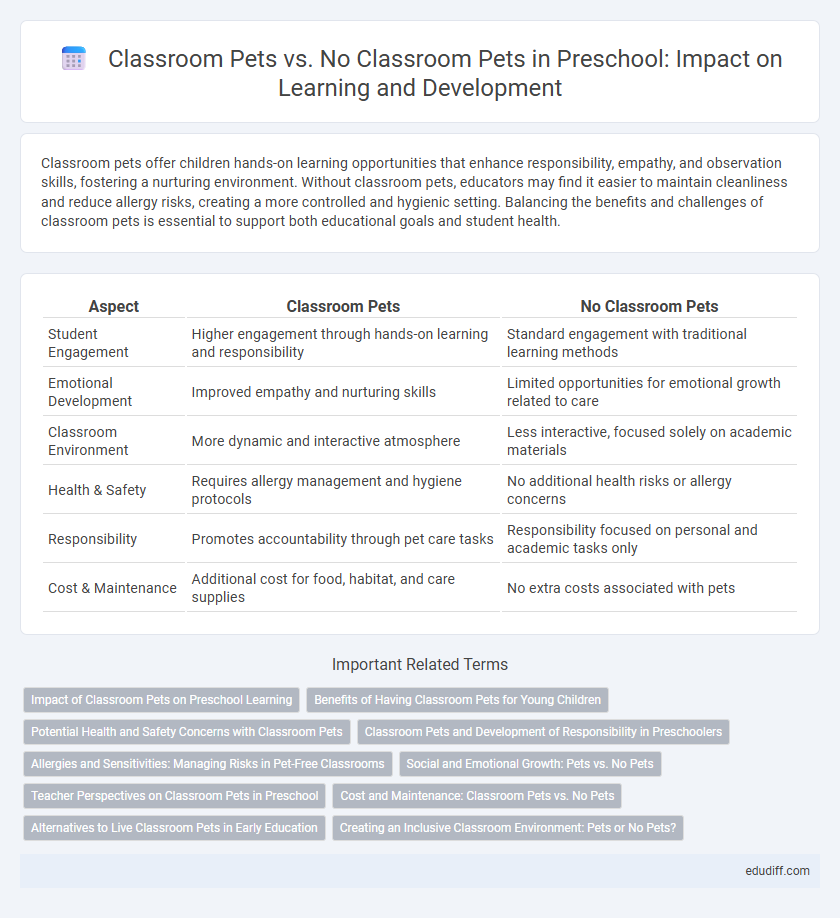Classroom pets offer children hands-on learning opportunities that enhance responsibility, empathy, and observation skills, fostering a nurturing environment. Without classroom pets, educators may find it easier to maintain cleanliness and reduce allergy risks, creating a more controlled and hygienic setting. Balancing the benefits and challenges of classroom pets is essential to support both educational goals and student health.
Table of Comparison
| Aspect | Classroom Pets | No Classroom Pets |
|---|---|---|
| Student Engagement | Higher engagement through hands-on learning and responsibility | Standard engagement with traditional learning methods |
| Emotional Development | Improved empathy and nurturing skills | Limited opportunities for emotional growth related to care |
| Classroom Environment | More dynamic and interactive atmosphere | Less interactive, focused solely on academic materials |
| Health & Safety | Requires allergy management and hygiene protocols | No additional health risks or allergy concerns |
| Responsibility | Promotes accountability through pet care tasks | Responsibility focused on personal and academic tasks only |
| Cost & Maintenance | Additional cost for food, habitat, and care supplies | No extra costs associated with pets |
Impact of Classroom Pets on Preschool Learning
Classroom pets enhance preschool learning by promoting responsibility, empathy, and social skills among young children. Studies show that interacting with pets can reduce stress and improve focus, leading to better engagement during lessons. Without classroom pets, these unique developmental benefits and hands-on learning opportunities may be significantly diminished.
Benefits of Having Classroom Pets for Young Children
Classroom pets provide young children with opportunities to develop responsibility, empathy, and social skills through daily care and observation. Interaction with animals has been shown to reduce stress and improve emotional well-being, enhancing focus and learning outcomes in preschool settings. Incorporating classroom pets into early education fosters a hands-on learning environment that supports cognitive and emotional growth.
Potential Health and Safety Concerns with Classroom Pets
Classroom pets can introduce potential health risks such as allergies, bacterial infections, and zoonotic diseases among preschool children. In contrast, no classroom pets eliminate these concerns, reducing the chance of asthma attacks or allergic reactions triggered by animal dander or saliva. Safety issues related to bites, scratches, or improper handling are also avoided in classrooms without pets, creating a more controlled and hygienic environment for young learners.
Classroom Pets and Development of Responsibility in Preschoolers
Classroom pets foster the development of responsibility in preschoolers by requiring daily care tasks such as feeding, cleaning, and monitoring. Engaging with pets enhances empathy, nurtures consistency, and promotes teamwork among young learners. Studies show that children with classroom pets demonstrate improved social skills and a stronger sense of accountability.
Allergies and Sensitivities: Managing Risks in Pet-Free Classrooms
Preschools without classroom pets minimize exposure to common allergens such as pet dander, fur, and saliva, significantly reducing the risk of triggering allergies and asthma in sensitive children. Maintaining a pet-free environment supports the health and safety of students with respiratory sensitivities and prevents potential allergic reactions that can disrupt learning activities. Implementing alternative engaging activities that do not involve animals ensures inclusivity while effectively managing allergy-related risks in early childhood education settings.
Social and Emotional Growth: Pets vs. No Pets
Classroom pets foster empathy, responsibility, and cooperation among preschool children, enriching their social and emotional development through daily care and interaction. In contrast, classrooms without pets may rely more heavily on teacher-facilitated activities to promote social skills, which can limit spontaneous opportunities for nurturing behavior. Research indicates that animals in educational settings significantly enhance emotional regulation and positive social interactions in young learners.
Teacher Perspectives on Classroom Pets in Preschool
Preschool teachers recognize that classroom pets foster responsibility, empathy, and engagement among young learners, enhancing social-emotional development and creating a nurturing environment. Conversely, concerns about allergies, hygiene, and animal care logistics lead some educators to prefer pet-free classrooms to maintain a controlled and safe setting. Balancing these perspectives, teachers often weigh educational benefits against practical challenges when deciding on classroom pet inclusion.
Cost and Maintenance: Classroom Pets vs. No Pets
Classroom pets require ongoing costs for food, habitat maintenance, and veterinary care, which can strain limited school budgets. No pets eliminate these expenses, allowing funds to be allocated toward educational materials and resources. Maintaining classroom pets demands daily care from teachers or students, potentially impacting instructional time, whereas no pets reduce maintenance responsibilities and administrative tasks.
Alternatives to Live Classroom Pets in Early Education
Alternatives to live classroom pets in early education include interactive digital pets, nature observation projects, and plant care activities, all promoting responsibility without the challenges of live animal care. Digital pets offer customizable and hygienic engagement, while observing local wildlife supports environmental learning and empathy. Incorporating plants into the classroom fosters nurturing skills and scientific inquiry in a low-maintenance, inclusive manner.
Creating an Inclusive Classroom Environment: Pets or No Pets?
Classroom pets foster inclusivity by encouraging responsibility, empathy, and social interaction among preschoolers, enhancing emotional development and cooperation. Conversely, no classroom pets minimize allergy risks and prevent distractions, creating a safer and more focused learning environment for diverse needs. Balancing these factors allows educators to tailor inclusivity strategies that support all children's well-being and engagement.
Classroom pets vs No classroom pets Infographic

 edudiff.com
edudiff.com